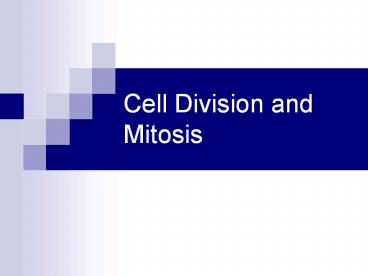Cell Division and Mitosis - PowerPoint PPT Presentation
1 / 29
Title:
Cell Division and Mitosis
Description:
Cell Division and Mitosis * * * * * * * Figure 8.7a Cell reproduction: A dance of the chromosomes. (Part 1) * Figure 8.7b Cell reproduction: A dance of the chromosomes. – PowerPoint PPT presentation
Number of Views:439
Avg rating:3.0/5.0
Title: Cell Division and Mitosis
1
Cell Division and Mitosis
2
Cell Division
- Cell division is the process by which cells
reproduce themselves. - Also known as cell reproduction.
- Cell division differs in prokaryotes and
eukaryotes. - However, cell reproduction in both produces the
same result two cells from one.
3
Cell Division in Prokaryotes
- Binary fission is the process of cell division in
prokaryotes. - Much simpler process than in eukaryotic organisms
- 3 step process
- Begins with DNA replication
- The two copies move to opposite sides of the cell
- Cell pinches into two new and identical cells
called "daughter cells".
4
Cell Division in Prokaryotes
5
Eukaryotic Cell Division
- Two forms
- Mitosis
- growth, replacement of dead or worn out cells, or
to repair wounds - Asexual reproduction in fungi, protists, some
plants/animals production of offspring from one
parent - Meiosis
- Formation of gametes haploid cells
- Sexual reproduction production of offspring
from two parents.
6
Cell Division in Eukaryotes
- Cell Cycle
- The cell cycle is the repeating set of events in
the life of a cell. - The cell cycle consists of cell division and
interphase. - Cell division in eukaryotes includes nuclear
division, called mitosis, and the division of
cytoplasm, called cytokinesis.
7
The Cell Cycle Interphase
- When a cell is not dividing it is said to be in
interphase. - Interphase consists of three stages
- G1 Gap, offspring cells grow to mature size
- S Synthesis, DNA replication occurs
- G2 Gap, cells are making sure all the DNA was
replicated correctly amount of cytoplasm
(including organelles) increases and the cell
prepares for cell division. - Another possibility
- G0 Phase cells do not prepare for cell division
- Generally exit from G1 phase
- Example fully developed cells in central nervous
system never divide again
8
The Cell Cycle
G0
9
The Cell Cycle Cell Division
- The mitotic (M) phase includes two overlapping
processes - Mitosis, in which the nucleus and its contents
divide evenly into two daughter nuclei - Cytokinesis, in which the cytoplasm is divided in
two
10
Mitosis and Cytokinesis
- Mitosis consists of four distinct phases
- (A) Prophase
- (B) Metaphase
- (C) Anaphase
- (D) Telophase
- Cytokinesis typically
- Occurs during telophase
- Divides the cytoplasm
- Is different in plant and animal cells
11
Cell Cycle
interphase
G1
S
telophase
anaphase
Mitosis
G2
metaphase
prophase
12
- Prophase
- -DNA condenses into rod-shaped chromosomes
- -Nucleolus and nuclear envelope disappear
- Appearance of two pairs of centrosomes in
animals these contain the centrioles - Centrosomes move toward opposite poles of the
cell - -spindle apparatus is assembled
13
- Spindle fibers are microtubles that radiate from
the centrosomes. - Array of spindle fibers are called mitotic
spindle. - Two types of spindle fibers
- Kinetochore fibers fibers that attach to a disk
shaped protein (called a kinetochore) found in
the centromere region of each chromosome. - Extend from the centrosomes to the kinetochore of
each chromatid - Polar fibers extend across the dividing cell
from centrosome to centrosome but do not attach
to the chromosomes.
14
- Spindle fibers microtubles which radiate from
the centrosomes. - Array of spindle fibers are called the mitotic
spindle. - Two types of spindle fibers
- Kinetochore fibers fibers that attached to a
disk-shape protein found in the centromere region
of each chromatid pair. - Polar fibers extend across the dividing cell
from centrosome to centrosome but do not attach
to the chromosomes.
15
(No Transcript)
16
- Metaphase
- -kinetochore fibers move the chromosomes to the
center of the cell
17
- Anaphase
- -Chromatids of each chromosome separate at the
centromere and slowly move, centromere first,
toward opposite poles. - -After the chromatids separate they are
considered to be individual chromosomes.
18
- Telophase
- -spindle apparatus disassembles
- -nuclear envelope forms around each set of sister
chromatids - -chromosomes begin to uncoil (chromatin state)
- -nucleolus reappears in each new nucleus
19
PROPHASE
INTERPHASE
Fragments of nuclear envelope
Early mitotic spindle
Centrosomes (with centriole pairs)
Centrosome
Chromatin
Centromere
Nuclear envelope
Chromosome, consisting of two sister chromatids
Spindle microtubules
Plasma membrane
LM
Figure 8.7.a
20
ANAPHASE
METAPHASE
TELOPHASE AND CYTOKINESIS
Cleavage furrow
Nuclear envelope forming
Spindle
Daughter chromosomes
Figure 8.7b
21
(No Transcript)
22
Cytokinesis
- Cytoplasmic Division
- Usually occurs between late anaphase and end of
telophase - Two mechanisms
- Cell plate formation (plants)
- Cleavage furrow (animals)
23
SEM
Cleavage furrow
Cleavage furrow
Contracting ring of microfilaments
Daughter cells
Figure 8.8a
24
Wall of parent cell
Cell plate forming
Daughter nucleus
LM
Vesicles containing cell wall material
New cell wall
Cell plate
Cell wall
Daughter cells
Figure 8.8b
25
S phase DNA synthesis chromosome duplication
Interphase Cell growth and chromosome duplication
G2
G1
Mitotic (M) phase
Genetically identical daughter cells
Cytokinesis (division of cytoplasm)
Mitosis (division of nucleus)
Figure 8.UN3
26
Cytokinesis Animal Cell
- Cleavage furrow
Figure 9.9Page 159
27
(No Transcript)
28
Cytokinesis Plant Cells
- Cell Plate Formation
Figure 9.8Page 158
29
Mitosis/Cytokinesis outcome
- 1 parent cell ? 2 identical daughter cells
- Chromosome number remains the same from one
generation to the next































